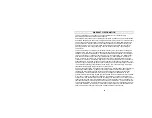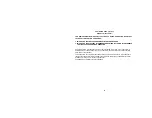
14
Clouds with Rain
—indicates that the weather is expected to get worse (not that the weather will
be rainy).
The weather icons change when the unit detects a change in air pressure. The icons change in
order, from “sunny” to “partly sunny” to “cloudy” or the reverse. It will not change from “sunny”
directly to “rainy”, although it is possible for the change to occur quickly. If the symbols do not
change then the weather has not changed, or the change has been slow and gradual.
Weather Tendency Arrows
Other possible displays in LCD 2 are 2 weather tendency arrows, one that points up (on the left
side of the forecast) and one that points down (on the right side of the forecast). These arrows
reflect current changes in the air pressure. An arrow pointing up indicates that the air pressure is
increasing and the weather is expected to improve or remain good. An arrow pointing down
indicates that the air pressure is decreasing and the weather is expected to become worse or
remain poor. No arrow means the pressure is stable.
POSITIONING
Before permanently mounting ensure that the atomic clock is able to receive WWVB signals from
the desired location. Also, extreme and sudden changes in temperature will decrease the
accuracy of the atomic clock, and changes in elevation will result with inaccurate temperatures
readings for the next 12 to 24 hours. These changes will require a 12 to 24 hour wait before
obtaining reliable data.
To achieve a true temperature reading, avoid mounting where direct sunlight can reach the
outdoor temperature transmitter. It is recommended to mount the outdoor temperature
transmitter on a North-facing wall or in any well shaded area. The maximum transmitting range is
330 feet (100 meters). Obstacles such as walls, concrete, and large metal objects can reduce the
range.
Place both units in their desired location, and wait approximately 10 minutes before permanently
mounting to ensure that there is proper reception. The outdoor temperature transmitter is not
waterproof and should not be placed anywhere it will become submerged in water or be directly in
the rain.
POSITIONING THE ATOMIC CLOCK:
There are two possible ways to mount the atomic clock:
•
use of the foldout table stands, or







































